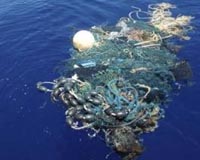| . |  |
. |
Southampton UK (SPX) Feb 17, 2010 Evidence from the Challenger Deep - the deepest surveyed point in the world's oceans - suggests that tiny single-celled creatures called foraminifera living at extreme depths of more than ten kilometres build their homes using material that sinks down from near the ocean surface. The Challenger Deep is located in the Mariana Trench in the western Pacific Ocean. It lies in the hadal zone beyond the abyssal zone, and plunges down to a water depth of around 11 kilometres. "The hadal zone extends from around six kilometres to the deepest seafloor. Although the deepest parts of the deepest trenches are pretty inhospitable environments, at least for some types of organism, certain kinds of foraminifera are common in the bottom sediments," said Professor Andrew Gooday of the National Oceanography Centre, Southampton (NOCS) and member of a UK-Japanese team studying these organisms in samples collected in 2002 during a Japan-USA-Korea expedition to study life in the western depression of the Challenger Deep. The researchers, whose findings appear in the latest issue of the journal Deep Sea Research, used the remotely operated vehicle KAIKO, operated by the Japan Agency for Marine-Earth Science and Technology (JAMSTEC), to take core samples from the soft sediment of the trench floor. Among many foraminiferans with an organic shell (or 'test'), they found four undescribed specimens with agglutinated tests. "The Challenger Deep is an extreme environment for agglutinated foraminifera, which construct their tests from a wide range of particles cemented together by calcareous or organic matter," said Gooday. "At these great depths, particles made from biologically formed calcite and silica, as well as minerals such as quartz, should dissolve, leaving only clay grains available for test building." The researchers were therefore surprised to discover that foraminiferan tests sampled from the Challenger Deep contained calcareous components, including the dissolved remnants of coccoliths, the calcium carbonate plates of tiny algae called coccolithophores, and planktonic foraminiferan test fragments. The organic test surface of one species was densely pitted with imprints, which the researchers interpreted as representing mineral grains of various types, including quartz, which subsequently dissolved. Agglutinated particles, presumed to be clay minerals, survived only in one specimen. "Our observations demonstrate that coccoliths, and probably also planktonic foraminiferan tests, reach the Challenger Deep intact," said Gooday. "These particles were probably transported to these extreme depths in rapidly sinking marine snow, the aggregated remains of phytoplankton that lived in the sunlit surface ocean, or in faecal pellets from zooplankton." It seems likely, therefore, that at least some agglutinated foraminifera living at extreme hadal depths build their homes from material that sinks down from the ocean above, rather like manna from heaven. ### Original publication: Gooday, A. J., Uematsu, K., Kitazato, H., Toyofuku, T. and Young, J. R. "Traces of dissolved particles, including coccoliths, in the tests of agglutinated foraminifera from the Challenger Deep (10,897 m water depth, western equatorial Pacific)." Deep Sea Research Part I: Oceanographic Research Papers 57(2), 239-247 (2010). doi:10.1016/j.dsr.2009.11.003 This study was supported by the Japan Society for the Promotion of Science and the OCEANS 2025 Strategic Research Programme of the UK Natural Environment Research Council. The researchers are Andrew Gooday (NOCS), K. Uematsu (Marine Works Japan Ltd, Yokosuka, Japan), H. Kitazato and T. Toyofuku (JAMSTEC), and J. R. Young (Natural History Museum, London). The National Oceanography Centre, Southampton (NOCS) is the UK's focus for ocean science. It is one of the world's leading institutions devoted to research, teaching and technology development in ocean and Earth science. Over 500 research scientists, lecturing, support and seagoing staff are based at the Centre's purpose-built waterside campus in Southampton along with over 700 undergraduate and postgraduate students. The NOCS is a collaboration between the University of Southampton and the Natural Environment Research Council (NERC). The NERC royal research ships RRS James Cook and RRS Discovery are based at NOCS, as is the National Marine Equipment Pool which includes Autosub and Isis, two of the world's deepest diving research vehicles. From April 1, 2010, NERC-managed activity at the NOCS joins forces with the Proudman Oceanographic Laboratory in Liverpool to form a new, national research organisation-- the National Oceanography Centre (NOC). The NOC will work in partnership with the UK marine research community to deliver integrated marine science and technology from the coast to the deep ocean. The University of Southampton will be one of the NOC's two hosting partners, the other being the University of Liverpool.
Share This Article With Planet Earth
Related Links National Oceanography Centre, Southampton (UK) Water News - Science, Technology and Politics
 Global efforts to clean oceans have failed
Global efforts to clean oceans have failedBerlin (UPI) Feb 16, 2009 EU and U.N. efforts to clean the polluted oceans of the world have failed, a leaked document from the German government indicated. Most of what people eat, drink or use comes packaged in petroleum-based plastic. Each year, plastic makers produce 240 million tons of the material. Some of the plastic is recycled, most is burned or buried in landfills but an increasing amount ends up pollu ... read more |
|
| The content herein, unless otherwise known to be public domain, are Copyright 1995-2010 - SpaceDaily. AFP and UPI Wire Stories are copyright Agence France-Presse and United Press International. ESA Portal Reports are copyright European Space Agency. All NASA sourced material is public domain. Additional copyrights may apply in whole or part to other bona fide parties. Advertising does not imply endorsement,agreement or approval of any opinions, statements or information provided by SpaceDaily on any Web page published or hosted by SpaceDaily. Privacy Statement |